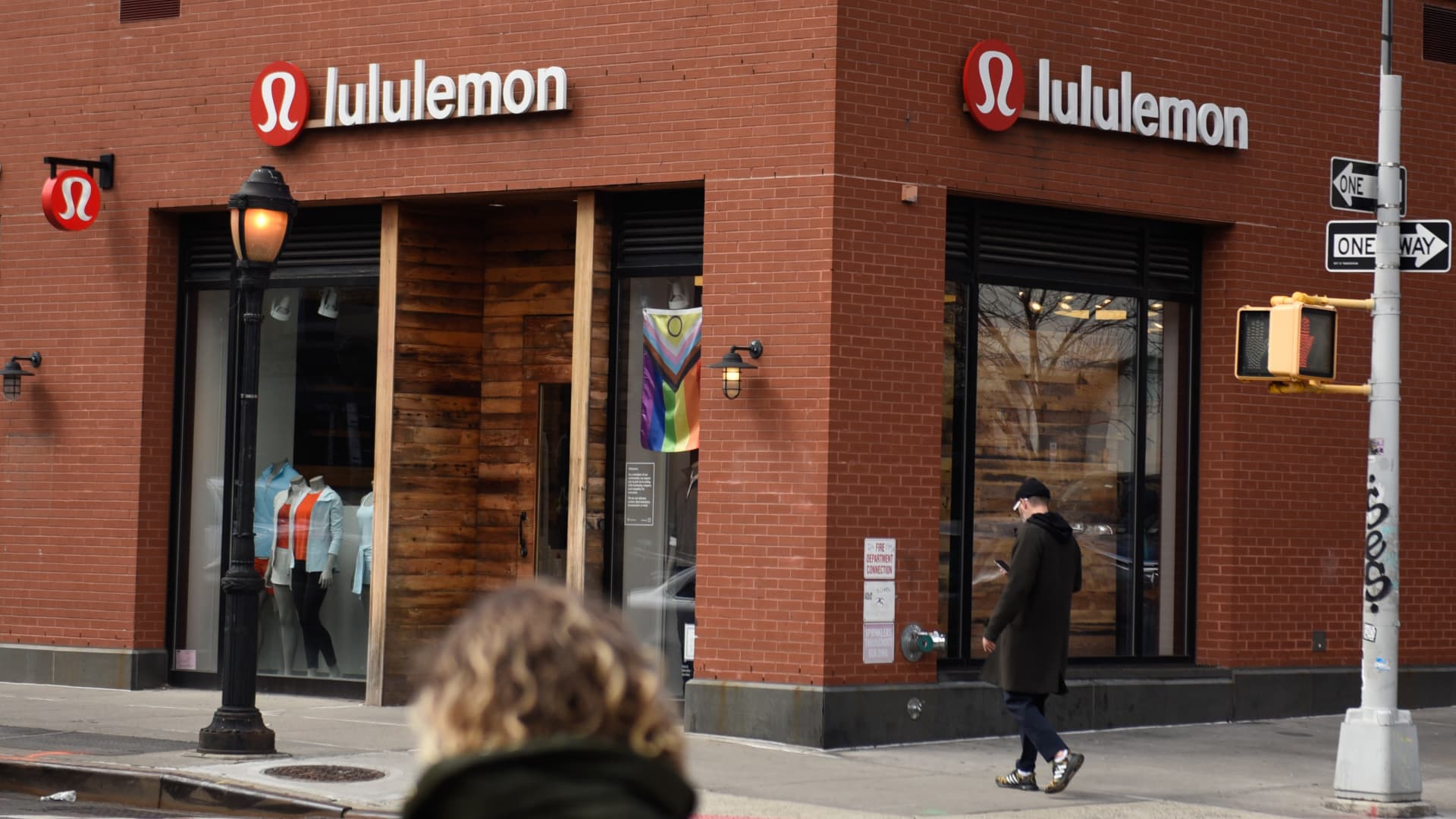Lululemon reported earnings that beat Wall Street’s estimates on the top and bottom lines Thursday and raised its full-year guidance, bolstered by improvements in China and freight costs.
Shares of the company surged more than 12% in extended trading.
related investing news
Here’s how the retailer did in its fiscal first quarter compared with what Wall Street was anticipating, based on a survey of analysts compiled by Refinitiv:
- Earnings per share: $2.28 vs. $1.98 expected
- Revenue: $2 billion vs. $1.93 billion expected
The company’s reported net income for the three-month period that ended April 30 was $290.4 million, or $2.28 per share, compared with $190 million, or $1.48 per share, a year earlier.
Sales rose 24% to $2 billion, up from $1.61 billion a year earlier.
China revenue alone grew 79% from the year-ago period, when the country was still reeling from Covid restrictions and roughly one-third of Lululemon’s 71 China stores were closed for a period of time.
“Our Q1 results were strong as guests responded well to our product offering in all our markets across the globe. A meaningful acceleration in our China sales trend, coupled with lower air freight, contributed to our better than planned financial performance,” CFO Meghan Frank said in a statement. “We are pleased with our momentum heading into the second quarter and for the full year as reflected in our revised outlook for FY23.”
The retailer now expects to see full-year revenue of $9.44 billion to $9.51 billion, up from a previous range of $9.31 billion and $9.41 billion, and beating Wall Street’s projections of $9.37 billion, according to Refinitiv. It expects full year profits of $11.74 to $11.94 per share, compared with a prior range of $11.50 to $11.72. That also topped analysts’ expectations, which called for $11.61 per share, according to Refinitiv.
Lululemon is expecting second-quarter sales to be in the range of $2.14 billion to $2.17 billion, representing growth of about 15%. Lululemon expects diluted earnings per share to be in the range of $2.47 to $2.52 for the period. That second-quarter guidance was largely in line with Wall Street expectations, according to Refinitiv.

The apparel retailer, which sells high-end yoga pants, shoes and other athletic wear, saw a 24% year-over-year increase in sales, even as it lapped strong comparisons in the year ago period, which came during an easier macroeconomic backdrop.
This time last year, Lululemon had just raised its prices, but shoppers were still flocking to its stores and filling up their digital carts. And, they weren’t yet feeling the pressure of persistent inflation.
Comparable store sales in the most recent quarter jumped 13%, compared with StreetAccount estimates of 8.3% growth. Direct-to-consumer revenue, however, increased 16% from the prior-year period, falling short of the 22.3% jump analysts had expected, according to StreetAccount.
While DTC revenue increased compared to last year, it represented 42% of total sales, compared to 45% in the year-ago period.
Gross margins in the quarter increased 3.6 percentage points to 57.5%. That was above the 56.7% margins analysts had been expecting, according to StreetAccount.
Discretionary spending
While the company largely caters to higher-income consumers, who tend to fare better against macroeconomic pressure, retailers across the industry have cited a pullback in discretionary spending and higher-ticket items.
During Nordstrom’s earnings call Wednesday evening, executives noted the high-end customer is “pretty resilient” but they’ve also become more cautious.
During this earnings season, some analysts cautioned soft goods retailers, or those that sell items such as clothes and shoes, could see a drop in margins because of increased promotional activity and an overall pullback across the sector.
The results so far this quarter have been mixed.
Many retailers have benefited from supply chain tailwinds, such as reduced freight costs, that have boosted their margins. But for some, a lot of those savings evaporated because of increased promotions and upticks in shrink, among other headwinds.
That rang true for Foot Locker, but others in the category, including Gap and Urban Outfitters, were able to hold the line on promotions and saw benefits to their margins.
Hardware
Last month, CNBC reported Lululemon is looking to sell its at-home fitness business Mirror and has approached competitor Hydrow as a potential buyer.
The company announced it would acquire Mirror for $500 million at the height of the at-home fitness bonanza in June 2020 in a bet that people would continue to exercise at home, even after Covid pandemic restrictions ended and gyms reopened.
The segment has since rebranded as lululemon Studio but has been weighing on Lululemon’s balance sheet.
During its previous fiscal quarter, the company said it took $443 million in impairment charges related to Mirror and told investors hardware sales have come in below expectations.
Lululemon acknowledged the at-home fitness market has been under pressure. Similar to Peloton, it has begun pivoting the segment away from being solely hardware-focused.


